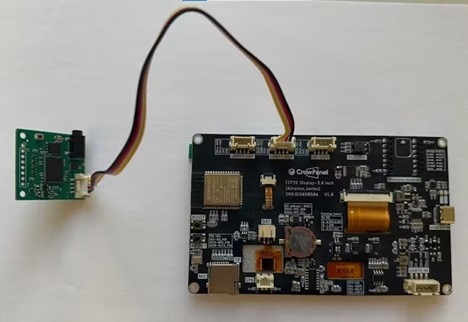This is a small interactive quiz that uses a touch UI, simple graphics, and an offline speech module to create a playful way to learn about animals.
When the user taps the screen, the device shows a short question, speaks it offline, and then displays the correct animal along with an optional explanation. The goal was to make a light, self-contained form of electronic entertainment that reacts immediately, without cloud services or complex software stacks.
The project runs on a compact MCU-based system with a capacitive touch screen and a tiny speech synthesizer module.
Each quiz item consists of an image, a short text line, and a spoken phrase.
The device displays an animal, waits for a tap, and then plays the corresponding spoken hint.
Because everything is generated on the microcontroller, the reaction feels fast and natural.
The same template can be reused for other simple games: geography quizzes, vocabulary trainers, museum exhibits, or STEM activities for kids.
In this version, the focus is on animals — a straightforward theme that makes the game easy to test and fun to demonstrate.
Components / Materials Used
-
Elecrow CrowPanel (5–7 inch touch display) – the main touchscreen interface that runs the quiz UI and sends commands when the user taps an animal
-
Grovety TinyTTS Kit – an offline speech module that generates spoken phrases directly on its internal microcontroller.
-
Small speaker – connected to the TinyTTS audio output for playback
-
UART cable / connection wires – to connect CrowPanel to the TinyTTS module
-
5V USB power source – used to power the system
System Overview / How It Works
The system consists of two main parts:
-
a touchscreen interface running on the Elecrow CrowPanel, and
-
a TinyTTS module that generates speech offline.

The CrowPanel displays a simple grid of animal images. Each image corresponds to a short description line stored in the project assets. When the user taps an animal, the CrowPanel sends a small UART message to the TinyTTS module. The message contains the ID of the selected animal, which determines what phrase should be spoken.
The TinyTTS module receives the command and immediately synthesizes the corresponding audio line on-device. The output is sent directly to a small speaker. Because everything runs locally on microcontrollers and does not rely on cloud services, the reaction feels instant: touch → message → speech.
This architecture makes the system easy to extend. New quiz items require only an additional image and a short text string. The speech module handles all audio generation internally, without external audio files or pre-recorded samples.
Running the Firmware
You can use the project in two ways:
Option A — Run the ready-made firmware (no coding required)
This is the fastest way to try the quiz.
-
Download the prebuilt firmware bundle from the project repository (from the firmware/ folder).
-
Run the included Flash Tool — it flashes all required images with the correct layout.
Option B — Build from source
This option is for modifying the UI, quiz logic, or integrating new content.
-
Open the project directory in ESP-IDF.
-
Build and flash:
idf.py build idf.py -p PORT flash


